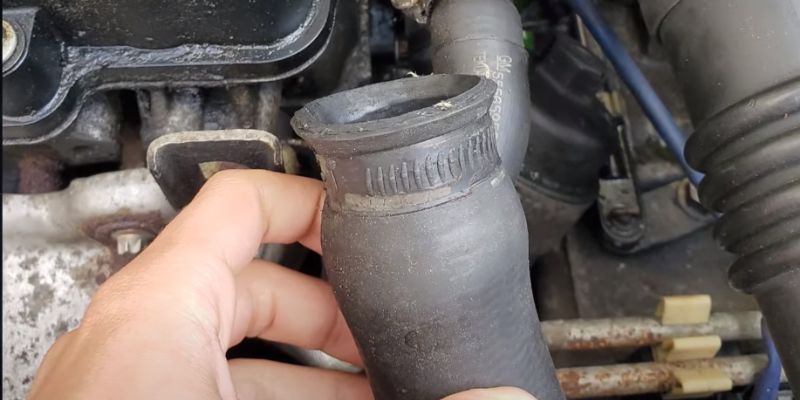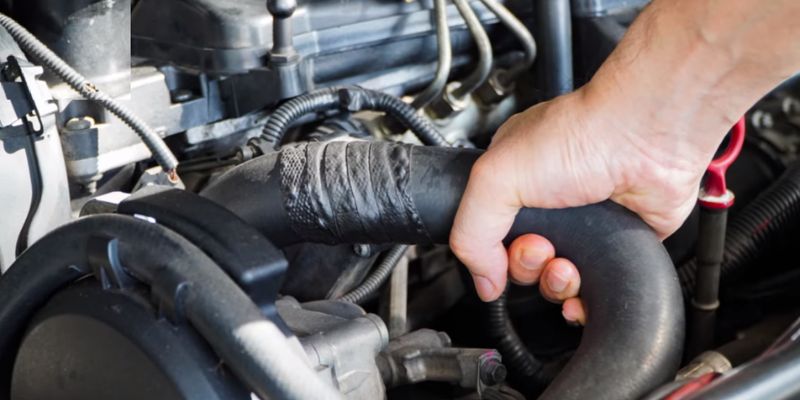Radiator hoses play a critical yet overlooked role in regulating engine temperature. As the connection between the heated engine and cooled radiator, these hoses are responsible for continuously circulating coolant.
In this article, we will guide you through the role of the radiator in a cooling system and the temperature difference between top and bottom radiator hoses.
Why is the bottom radiator hose typically cooler than the top hose?
The reason the bottom radiator hose usually runs cooler involves basic fluid dynamics within the cooling system.
Hot coolant exiting the engine block enters the top radiator hose on its way to the radiator core that’s why the upper radiator hose is always hotter than the lower hose.
Here, the coolant transfers its heat to the radiator fins, and air passes through. By the time this cooled fluid emerges from the bottom of the radiator, its temperature has dropped significantly before beginning the return trip up the bottom hose back to the engine.
Thus, there is a natural temperature differential based on the direction of coolant flow and heat rejection process occurring within the radiator compartments.
Only factors that disturb this circulation pattern cause abnormal temperature variations outside specifications.
What is the significance of the temperature difference between top and bottom radiator hoses?
The top and bottom radiator hoses play a crucial role in regulating engine temperature by effectively circulating coolant between the engine and radiator.
An important aspect of monitoring cooling system health is checking for any significant discrepancies in temperature between these two hoses.
An uneven temperature distribution can indicate inefficiencies or problems developing within the cooling circuit. Maintaining an optimal temperature balance is important for prolonged engine life and performance.

Importance of coolant flow in the radiator hoses
Proper coolant flow is essential for transferring excess heat from the engine block out to the radiator where it can be dissipated. The top and bottom radiator hoses facilitate this continuous exchange of hot and cold coolant.
As hot coolant from the engine enters the top hose, it then flows down into the radiator. Simultaneously, cooler coolant is drawn up from the bottom hose back into the engine.
This regulated circulation loop keeps engine temperature within ideal operating parameters. Disturbances to the smooth flow of coolant through the hoses can disrupt the temperature regulation process.
Effects of temperature variance on the cooling system
When there is a wide discrepancy between the temperatures of the top and bottom radiator hoses, it indicates an issue with the even distribution of hot and cold coolant through the cooling system.
A large temperature difference stresses components and makes it difficult for the thermostat to properly manage overall engine temp.
Over time, fluctuations in temperature take a toll on rubber and plastic materials like hoses, gaskets, and seals. They also exacerbate internal corrosion.
Precise thermal control is lost, increasing the chances of overheating or accelerated wear. Catching such problems early through regular hose temperature checks can avoid costly repairs down the line.
Role of the radiator hoses in regulating engine temperature
The radiator hoses have a direct impact on maintaining consistent engine operating temperature. As the main vessels transporting coolant, they must function efficiently without any obstructions to flow.
Regulate engine temperature
The hoses effectively regulate temperature by shuttling heated coolant away from the engine block and returning cooler coolant back.
Balanced Heat Transfer
Their flexible design also allows for expansion/contraction of the coolant during heating/cooling cycles.
Provided the hoses are intact and free of kinks/restrictions, they ensure continuous balanced heat transfer between the engine and radiator core.
Ultimately, their role is to keep temperature fluctuations to a minimum for dependable temperature management.
Problems caused by unequal temperature distribution in radiator hoses
When the temperature gap between the top and bottom radiator hoses is excessive, it often points to an impediment in the coolant’s circulation path.
Failed Thermostat
Possible causes could range from minor issues like a stuck-open thermostat allowing overcooling to more severe problems such as a failed water pump or cracked head/block.
Improper coolant flow
Lack of proper coolant flow breeds hot spots which can overheat and damage components quickly. It also interferes with thermostat function, disrupting temperature regulation.
Corrosion
Over time, a poorly circulating coolant supply accelerates internal corrosion and reduces the cooling system’s ability to dissipate engine heat efficiently.
These factors combine to compromise reliability and engine longevity.
Effect of heat dissipation on the lower radiator hose
When the coolant passes through the radiator core, the top section close to the engine remains hottest while the bottom cools significantly from rejecting heat to the surrounding air.
As convection draws the heavier cold coolant downwards, it collects at the bottom of the radiator prior to exiting through the lower hose.

After dumping its excess heat load into the radiator fins, this return coolant should register anywhere from 10-20°C cooler than the hot coolant departing the engine through the top hose.
The inherent design of the cooling system and process of radiant heat transfer account for the typical temperature differences observed.
Factors influencing temperature variance between the hoses
While a 10-20°C gap is considered normal, the precise difference can fluctuate slightly based on operating conditions.
External elements like ambient temperature, vehicle speed, and engine load impact heat rejection abilities.
High internal engine temps from extended idling or towing raise the hot coolant temperature, in turn affecting the spread.
Even factors such as coolant type, thermostat, radiator, and fan operation influence heat transfer dynamics. Understanding how these variables can potentially alter hose temperatures aids in diagnosing abnormal behavior outside usual operational parameters.
Connection between radiator design and temperature difference
The radiator’s physical layout also comes into play.
More compact designs with thicker fins and close core spacing boost surface area and efficient heat transfer. This allows for faster and more complete coolant cooling over shorter flow paths between core inlet and outlet sections.
Vehicles equipped with high-performance aluminum racing radiators, for instance, can achieve bottom hose temps almost on par with the top side due to radically increased cooling capacity.
More prominently finned OEM steel units see moderate differences as expected. Getting familiar with your particular vehicle’s radiator specifications supports proper temperature analysis.
Impact of thermostat operation on the temperature discrepancy
The thermostat valve directly influences temperature deltas by regulating coolant flow.
A stuck-open or partially closed thermostat impairs the engine’s ability to warm up fully. This allows bottom hose temperatures to drop significantly lower than usual— often below spec.
On the other hand, a stuck-shut thermostat prevents coolant from dumping heat into the radiator until pressures escalate dangerously.
Both scenarios skew normal temperature readings by interfering with the balanced cycle of engine heating and radiator cooling that the thermostat controls. Proper thermostat functionality maintains ideal operating parameters.
How to diagnose and address temperature disparities in radiator hoses?
Assessing radiator hose temperatures need not involve fancy tools—a basic infrared thermometer will suffice. Compare top-to-bottom readings both cold and hot. Normal is a 10-20°C spread ideally under varying loads and speeds. Discrepancies over 30°C require troubleshooting potentials like:
- Coolant level/condition – low/dirty fluid starves the system
- Water pump – a failing pump decreases flow/heat transfer
- Thermostat – as discussed, open/closed issues disrupt temp control
- Radiator – deterioration reduces surface area or blocks airflow
- Airflow – clutch fans worn or obstructed Condensing/blown head gaskets also cause large differentials by isolating cylinder heat. Consult manuals for exact thresholds. Professional diagnosis helps pinpoint the root cause if issues persist after repairs or flushes to purge contaminants restoring balanced hose temps.
Common reasons for a significant temperature difference between hoses
Consistent large hose temperature variances above 30°C reveal an underlying cooling problem restricting efficient coolant flow and heat transfer.
Common culprits behind uneven temperature readings include:
- low coolant level
- failed water pump impeller
- restricted radiator
- stuck/faulty thermostat not properly regulating the flow
- head gasket failure allowing combustion gases into the cooling jacket.
Other potential factors are kinked or collapsed hoses, air pockets from incorrect bleeding after repairs, or a blocked oil cooler. Narrowing down potential causes through systematic testing and inspection helps find remedies.
A step-by-step guide to performing a radiator hose temperature check
Here is a step-by-step guide to performing a radiator hose temperature check:
- Ensure the engine is at normal operating temperature. This usually takes 15-20 minutes of driving once the temperature gauge reaches the middle.
- Safely park the vehicle in an open, level space and engage the parking brake.
- Locate the top and bottom radiator hoses. The top hose will be nearest the engine, while the bottom hose exits near the bottom of the radiator.
- Use an infrared thermometer gun aimed at the center of each hose to measure the surface temperature. Contact thermometers can also be used.
- Start by measuring the top hose temperature, then move to the bottom hose right away. Record both readings.
- For accurate results, take 3 separate temperature readings from each hose and record the highest values.
- The bottom hose should read 10-20°C cooler than the top. More than a 30°C difference may indicate an issue.
- Check your owner’s manual for the vehicle’s specified normal top-bottom temperature spread as well.
- Document your findings. Monitor temperatures at regular intervals or if symptoms arise.
- If a large discrepancy persists, further cooling system testing will help pinpoint potential problems like low fluid levels, stuck thermostats, or weak water pumps.
What role do radiator hoses play in regulating the overall coolant temperature?
As the connecting pipework between the engine and the radiator, the radiator hoses perform several crucial functions in maintaining optimal coolant temperature:
- Transmission of hot coolant from the engine: The upper hose carries hot coolant away from the engine block to the radiator for cooling. This transfers excess engine heat to begin the temperature regulation process.
- Regulation of coolant flow and temperature: The flexible hoses ensure unrestricted coolant circulation through bends and turns. They also regulate temperature by facilitating continuous exchange of hot and cold coolant between engine and radiator compartments.
- Relationship with hose condition: Worn, damaged, or kinked radiator hoses disrupt smooth coolant flow. Their inability to efficiently transfer thermal energy stresses both hoses and cooling systems over time.
Impact of faulty radiator hoses on coolant temperature and engine performance
When radiator hoses degrade or develop restrictions, they interfere with precise coolant flow regulation. This compromises the engine’s ability to maintain optimal temperature for several reasons:
- Reduced heat transfer slows coolant cooling through the radiator under load. Overheating risk increases from inadequate waste heat removal.
- Restricted flow starves cylinders and promotes hot spots leading to premature parts wear and failure.
- Thermostat control becomes erratic due to uneven temperature distribution, stressing cooling system components.
Optimizing radiator hose performance for effective temperature control
To maximize temperature regulation, the radiator hoses themselves must be maintained in top condition. Replacing worn hoses ensures maximum coolant flow rate and unrestricted heat transfer between engine and radiator. This keeps temperature fluctuations minimal for peak performance and durability.
How does proper maintenance of radiator hoses contribute to temperature control?
Regular inspection and maintenance help radiator hoses operate at peak efficiency for precise temperature management:
- Importance of regular inspection: Checking for cracks, softening, or bulges every 30k miles catches minor issues before failures.
- Replacement schedule: Following age guidelines prevents degradation from heat cycling and ensures safety.
- Enhancing circulation: Like-new hoses optimize flow rate and temperature control by eliminating restrictions.
- Preventive measures: Proper securing, avoiding kinks, and using OEM-quality parts extend hose lifespan dramatically.
FAQs
Should top and bottom radiator hoses be the same temp?
In a properly functioning cooling system, the top and bottom radiator hoses should not necessarily be the same temperature.
Generally, the top hose will carry hot coolant from the engine to the radiator, while the bottom hose returns cooler coolant from the radiator to the engine.
The temperature difference indicates that heat is being exchanged in the radiator, helping to cool the coolant before it circulates back through the engine.
If both hoses are extremely hot or cold, it might signal an issue, such as a malfunctioning thermostat or a blocked radiator, and further inspection is recommended.
What is the temperature of the upper radiator hose?
The temperature of the upper radiator hose is typically in the range of 190–200 °F (88–93 °C) when the engine is operating under normal conditions. This temperature range ensures effective heat transfer, helping to cool the engine and maintain optimal performance.
Is upper or lower radiator hose hotter?
The upper radiator hose is generally hotter than the lower radiator hose. The upper hose carries hot coolant from the engine to the radiator, where the heat is dissipated. In contrast, the lower hose returns cooler coolant from the radiator to the engine.
How often should radiator hoses be replaced?
As a general guideline, it’s advisable to replace radiator hoses every 4 to 5 years or around 60,000 to 100,000 miles (96,000 to 160,000 kilometers), even if they appear to be in good condition.
However, if you notice signs of wear, such as cracks, bulges, or soft spots, it’s crucial to replace the hoses promptly to prevent potential coolant leaks and ensure the proper functioning of the cooling system.
Conclusion
Radiator hoses fulfill a vital yet overlooked role in managing engine temperature. Through efficient coolant circulation, they facilitate precise thermal regulation critical to performance and longevity.
Simple temperature checks on these hoses provide a wealth of insight into cooling system function. Understanding variations empowers early problem identification before the damage.
With radiator hoses properly maintained, temperature control can be optimized for dependable operation. Appreciating their work keeps the engine cool and protects the substantial investment underneath the hood.

Joseph Morgan has decades of automotive experience. The Detroit native started restoring classics in the 1970s. He owned a vintage repair shop and authored articles for car magazines. With a 1965 Mustang fastback of his own, Joseph now shares advice through his YouTube channel. From engine swaps to rust repair, his expertise helps preserve automotive history.
